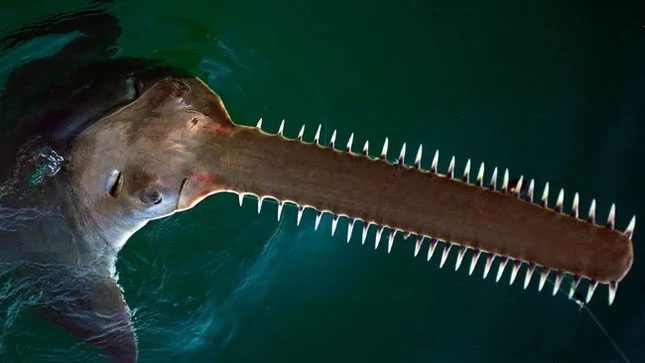The endangered sawfish species in Florida has been found unusually stranded in shallow waters, facing the risk of premature death. Scientists report that this unusual behavior of the fish is currently inexplicable.
Adam Brame, the sawfish recovery coordinator at the National Oceanic and Atmospheric Administration (NOAA) in the U.S., stated: “There have been over a hundred reports of affected sawfish, with more than 30 confirmed deaths.”
According to a statement, the increasing number of sawfish deaths began in October 2023 along the Florida Keys coastline, and so far, 32 sawfish (Pristis pectinata) have died, although NOAA officials believe this number is likely incomplete. Expert Brame indicated that the cause of death is due to sawfish stranding on beaches.

Sawfish at risk of extinction due to frequent stranding on beaches.
Footage posted on Facebook in early April shows a sawfish spinning near the shore. Water samples did not reveal any abnormalities in water quality or levels of inorganic or organic chemicals. However, tests identified elevated concentrations of algae from the genus Gambierdiscus, according to Bonefish & Tarpon Trust. Some algal blooms are harmless, but certain species, including Gambierdiscus, produce neurotoxins that can be harmful to humans and animals in the area.
Water and tissue samples continue to be tested to determine the cause. The affected sawfish are typically large and mature, measuring between 2.1 to 4.2 meters long.
The species is at risk of extinction
Historically, sawfish have inhabited the coastlines of the Americas from the United States to Brazil, but they are now primarily found in southwestern Florida, USA. According to the International Union for Conservation of Nature’s Red List of Threatened Species, this species is critically endangered—mainly due to overfishing and habitat destruction.
In October 2023, the species’ strange swimming behavior was first reported in the area. Locals described the fish displaying unusual swimming patterns, such as erratically swimming in circles or swimming upside down. By the end of January 2024, scientists had just received these reports.
According to a statement from the Florida Fish and Wildlife Conservation Commission, the agency leading the investigation, researchers examined the deceased sawfish but found no signs of infectious diseases or bacterial infections that could have caused their deaths. They hope to develop a rescue strategy aimed at returning sawfish to the wild and ensuring their healthy survival.


















































